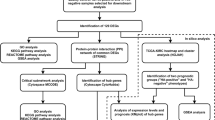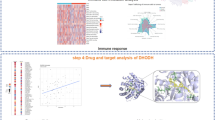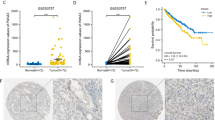Abstract
Hyaluronan and proteoglycan link protein 3 (HAPLN3) is a member of the hyaluronan and proteoglycan link protein family expressed in the extracellular matrix closely associated with the development and occurrence of various malignant tumors; yet, its function in clear cell renal cell cancer (ccRCC) is still poorly understood. The following study investigated the progress and mechanism of HAPLN3 on ccRCC using bioinformatics analysis and in vitro experiments. In order to determine whether HAPLN3 is differentially expressed in ccRCC, we analyzed data from the Cancer Genome Atlas (TCGA) and GSE40435 and further validated them in the Human Protein Atlas (HPA) database. Simultaneously, the TCGA dataset was utilized to study the relationship between HAPLN3 expression and the progression of ccRCC and its prognostic value in ccRCC. Gene enrichment analysis (GSEA) was used to explore HAPLN3-related signaling pathways in ccRCC. The TIMER database investigates the link for both HAPLN3 and immune cell infiltration. Different ccRCC cell lines the role of HAPLN3 on cell biological behavior in vitro. HAPLN3 was increased in ccRCC, and its high expression was related to the patients' survival rates and clinical characteristics. GSEA showed that HAPLN3 is mainly enriched in proliferative and metastatic pathways. In addition, HAPLN3 was an independently associated significant predictor in patients with ccRCC. Functional experiments demonstrated that HAPLN3 could promote the proliferation, migration, and invasion of ccRCC cells through the ERK1/2 signaling pathway. To sum up, our data suggest that HAPLN3 may serve as a new prognostic biomarker and potential therapeutic target for ccRCC.










Similar content being viewed by others
References
Atkins MB, Tannir NM (2018) Current and emerging therapies for first-line treatment of metastatic clear cell renal cell carcinoma. Cancer Treat Rev 70:127–137
Bjerre MT, Nørgaard M, Larsen OH, Jensen S, Strand SH, Østergren P, Fode M, Fredsøe J, Ulhøi BP, Mortensen MM, Jensen JB et al (2020) Epigenetic analysis of circulating tumor DNA in localized and metastatic prostate cancer: evaluation of clinical biomarker potential. Cells 9(6):1362
Choueiri TK, Motzer RJ (2017) Systemic therapy for metastatic renal-cell carcinoma. N Engl J Med 376(4):354–366
Evanko SP, Gooden MD, Kang I, Chan CK, Vernon RB, Wight TN (2020) A role for HAPLN1 during phenotypic modulation of human lung fibroblasts in vitro. J Histochem Cytochem 68(11):797–811
Fasoulakis Z, Daskalakis G, Theodora M, Antsaklis P, Sindos M, Diakosavvas M, Angelou K, Loutradis D, Kontomanolis EN (2021) The relevance of notch signaling in cancer progression. Adv Exp Med Biol 1287:169–181
Gaudreau PO, Negrao MV, Mitchell KG, Reuben A, Corsini EM, Li J, Karpinets TV, Wang Q, Diao L, Wang J, Federico L et al (2021) Neoadjuvant chemotherapy increases cytotoxic T cell, tissue resident memory T cell, and B cell infiltration in resectable NSCLC. J Thorac Oncol 16(1):127–139
Hsieh JJ, Purdue MP, Signoretti S, Swanton C, Albiges L, Schmidinger M, Heng DY, Larkin J, Ficarra V (2017) Renal cell carcinoma. Nat Rev Dis Primers 3:17009
Huang W, Li Y, Zhang C, Zha H, Zhou X, Fu B, Guo J, Wang G (2020) IGF2BP3 facilitates cell proliferation and tumorigenesis via modulation of JAK/STAT signalling pathway in human bladder cancer. J Cell Mol Med 24(23):13949–13960
Ivanova AV, Goparaju CM, Ivanov SV, Nonaka D, Cruz C, Beck A, Lonardo F, Wali A, Pass HI (2009) Protumorigenic role of HAPLN1 and its IgV domain in malignant pleural mesothelioma. Clin Cancer Res 15(8):2602–2611
Jiang T, Lu X, Yang F, Wang M, Yang H, Xing N (2020) LMTK3 promotes tumorigenesis in bladder cancer via the ERK/MAPK pathway. FEBS Open Bio 10(10):2107–2121
Kaszak I, Witkowska-Piłaszewicz O, Niewiadomska Z, Dworecka-Kaszak B, Ngosa TF, Jurka P (2020) Role of Cadherins in cancer-a review. Int J Mol Sci 21(20):7624
Kuo SJ, Chien SY, Lin C, Chan SE, Tsai HT, Chen DR (2010) Significant elevation of CLDN16 and HAPLN3 gene expression in human breast cancer. Oncol Rep 24(3):759–766
Li T, Fu J, Zeng Z, Cohen D, Li J, Chen Q, Li B, Liu XS (2020) TIMER2.0 for analysis of tumor-infiltrating immune cells. Nucleic Acids Res 48(W1):W509–W514
McLaughlin M, Patin EC, Pedersen M, Wilkins A, Dillon MT, Melcher AA, Harrington KJ (2020) Inflammatory microenvironment remodelling by tumour cells after radiotherapy. Nat Rev Cancer 20(4):203–217
Mittal V (2018) Epithelial mesenchymal transition in tumor metastasis. Annu Rev Pathol 13:395–412
Ogawa H, Oohashi T, Sata M, Bekku Y, Hirohata S, Nakamura K, Yonezawa T, Kusachi S, Shiratori Y, Ninomiya Y (2004) Lp3/Hapln3, a novel link protein that co-localizes with versican and is coordinately up-regulated by platelet-derived growth factor in arterial smooth muscle cells. Matrix Biol 23(5):287–298
Pistritto G, Trisciuoglio D, Ceci C, Garufi A, D’Orazi G (2016) Apoptosis as anticancer mechanism: function and dysfunction of its modulators and targeted therapeutic strategies. Aging (albany NY) 8(4):603–619
Rappold PM, Silagy AW, Kotecha RR, Hakimi AA (2021) Immune checkpoint blockade in renal cell carcinoma. J Surg Oncol 123(3):739–750
Skoda AM, Simovic D, Karin V, Kardum V, Vranic S, Serman L (2018) The role of the Hedgehog signaling pathway in cancer: a comprehensive review. Bosn J Basic Med Sci 18(1):8–20
Sohn EJ, Jung DB, Lee H, Han I, Lee J, Lee H, Kim SH (2018) CNOT2 promotes proliferation and angiogenesis via VEGF signaling in MDA-MB-231 breast cancer cells. Cancer Lett 412:88–98
Spicer AP, Joo A, Bowling RA Jr (2003) A hyaluronan binding link protein gene family whose members are physically linked adjacent to chondroitin sulfate proteoglycan core protein genes: the missing links. J Biol Chem 278(23):21083–21091
Suarez C, Campayo M, Bastus R, Castillo S, Etxanitz O, Guix M, Sala N, Gallardo E (2018) Prognostic and predictive factors for renal cell carcinoma. Target Oncol 13(3):309–331
Subramanian A, Tamayo P, Mootha VK, Mukherjee S, Ebert BL, Gillette MA, Paulovich A, Pomeroy SL, Golub TR, Lander ES, Mesirov JP (2005) Gene set enrichment analysis: a knowledge-based approach for interpreting genome-wide expression profiles. Proc Natl Acad Sci U S A 102(43):15545–15550
Sun Y, Liu WZ, Liu T, Feng X, Yang N, Zhou HF (2015) Signaling pathway of MAPK/ERK in cell proliferation, differentiation, migration, senescence and apoptosis. J Recept Signal Transduct Res 35(6):600–604
Sung H, Ferlay J, Siegel RL, Laversanne M, Soerjomataram I, Jemal A, Bray F (2021) Global cancer statistics 2020: GLOBOCAN estimates of incidence and mortality worldwide for 36 cancers in 185 countries. CA Cancer J Clin 70:313
Tang J, Qin Z, Han P, Wang W, Yang C, Xu Z, Li R, Liu B, Qin C, Wang Z, Tang M et al (2017) High Annexin A5 expression promotes tumor progression and poor prognosis in renal cell carcinoma. Int J Oncol 50(5):1839–1847
Zhang Y, Zhang Z (2020) The history and advances in cancer immunotherapy: understanding the characteristics of tumor-infiltrating immune cells and their therapeutic implications. Cell Mol Immunol 17(8):807–821
Zhang YX, Yuan J, Gao ZM, Zhang ZG (2018) LncRNA TUC338 promotes invasion of lung cancer by activating MAPK pathway. Eur Rev Med Pharmacol Sci 22(2):443–449
Zhang W, Liu R, Zhang L, Wang C, Dong Z, Feng J, Luo M, Zhang Y, Xu Z, Lv S, Wei Q (2022) Downregulation of miR-335 exhibited an oncogenic effect via promoting KDM3A/YAP1 networks in clear cell renal cell carcinoma. Cancer Gene Ther 29:573–584
Zhao Y, Tang H, Zeng X, Ye D, Liu J (2018) Resveratrol inhibits proliferation, migration and invasion via Akt and ERK1/2 signaling pathways in renal cell carcinoma cells. Biomed Pharmacother 98:36–44
Acknowledgements
The results published in this study are from publicly available datasets, which are available in the TCGA database and the GEO database. This research was supported by the Natural Science Foundation of China (grant number 81860454) and Key Research and Development Program of Jiangxi Province (grant number 20203BBGL73180).
Funding
This research was supported by the Natural Science Foundation of China (grant number 81860454) and Key Research and Development Program of Jiangxi Province (grant number 20203BBGL73180).
Author information
Authors and Affiliations
Contributions
JG and YD: study design. YD, QP, SX, HH, and XC: data collection and analysis. YD and XC: performed the experiments. All authors contributed to data interpretation and the writing and review of this manuscript.
Corresponding author
Ethics declarations
Conflict of interest
The authors have declared that no competing interest exists.
Ethical approval
All procedures in this study were conducted in accordance with the First Affiliated Hospital Ethics Committee of Nanchang University. This article does not contain any studies with animal subjects.
Additional information
Publisher's Note
Springer Nature remains neutral with regard to jurisdictional claims in published maps and institutional affiliations.
Rights and permissions
Springer Nature or its licensor (e.g. a society or other partner) holds exclusive rights to this article under a publishing agreement with the author(s) or other rightsholder(s); author self-archiving of the accepted manuscript version of this article is solely governed by the terms of such publishing agreement and applicable law.
About this article
Cite this article
Ding, Y., Xiong, S., Chen, X. et al. HAPLN3 inhibits apoptosis and promotes EMT of clear cell renal cell carcinoma via ERK and Bcl-2 signal pathways. J Cancer Res Clin Oncol 149, 79–90 (2023). https://doi.org/10.1007/s00432-022-04421-3
Received:
Accepted:
Published:
Issue Date:
DOI: https://doi.org/10.1007/s00432-022-04421-3




